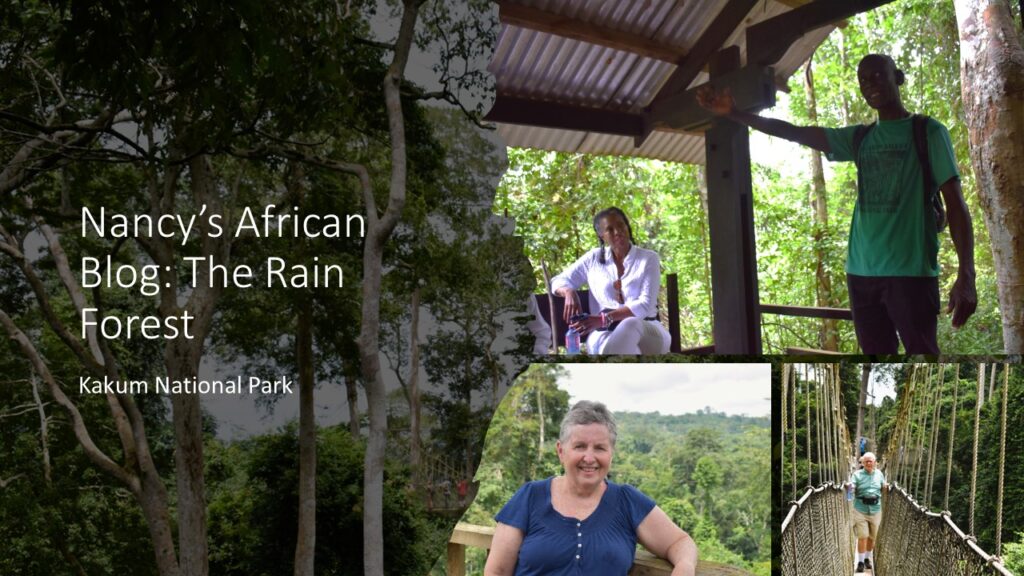
On our third day in Ghana, after the Naming Ceremony, we boarded our bus and headed off for the Kakum National Park. I’d researched this park online and looked forward to a walk in the tree canopy of the rain forest, hoping to see some African wildlife. Monkeys, antelopes, forest elephants and numerous colorful birds reside in the 145 mile square reserve.
When we arrived at the park, we were met by a guide for our group. Our leaders handed out raincoats, water bottles and walking sticks. First, we climbed up some steps and hiked up a path through the trees to reach the first platform that led to one of seven connected suspended walkways. The walkways were constructed with narrow planks of wood. Strong netting surrounded both sides of the wood, reaching up to a thick rope that we could use for handrails.
Eager to experience a rainforest and see some wildlife, I was the first one to venture out from our group. I had a great view and looked carefully among the trees below for hints of life. Unfortunately, the time of day and the number of people all around kept the wildlife in hiding. Nevertheless, it was a beautiful walk. Platforms attached to 400–500-year-old trees separated the walks and made a place to stop, enjoy the scenery and take pictures.
I could look across the trees and see other members of our group gingerly trudging across the planks. For some reason, it didn’t scare me, but the others felt differently, evidenced by my husband’s face when I waited for him at the platform. Several of the others had guides walking slowly, backwards, in front of them to encourage them to keep them moving along.
Like in most of the world, Africa is quickly losing its rain forests. In Ghana, the government preserved this one, just like we preserve important natural areas with our national park system.
26% of the land in Africa is classified as forest and the continent is home to 43 billion trees.
I looked up some information about deforestation elsewhere and discovered it continues to be a growing global problem. Forests absorb carbon in the atmosphere. The rain forests in the Congo of Africa are sometimes referred to the “lungs” of the planet, but as we lose our forests, it contributes to global warming.
The United States has witnessed the destruction of a staggering 75% of its virgin forests (since the 1600s). Worldwide, tropical deforestation contributes about 20% of annual global greenhouse gases (GHG) emissions. Every second, a forest the size of a football field is cut down. 40 percent of the tropical deforestation that occurred between 2000 and 2010 is a result of commercial agriculture like cattle ranching and oil palm plantations. At our current rate, all rainforests will be gone in 77 years. 50,000 species are lost each year as a result of deforestation. 25% of Western drugs and pharmaceuticals come from rainforest ingredients. 25% of all cancer fighting drugs come from the rainforest. 75% of tropical rainforests have lost the ability to properly recover from wildfires and drought.
If you’re like me, you’re concerned about the changing climate. People are working to plant trees in the U.S. to replace those cut down. And we are organizing to address the climate. I encourage you to get involved in these efforts if you’re not already. Check out Citizens’ Climate Lobby.. Take advantage of current incentives to rewire your home and your life. A big push toward electric energy will help wean us from fossil fuels. Check out the Rewiring America website. Here you can find the ways the Inflation Reduction Act can benefit you and your organization as you electrify your energy use. I keep incorporating issues about our changing climate in my writing. My latest novel is an environmental love story, Mariah of the Wind. My memoir, Letters from the Earth, is a about a year in my life when I was grappling with this problem.
We stopped at shelters to rest and to listen to our guide talk about the rain forest. His grandfather taught him the natural healing technique using plants. We asked him for advice on specific health problems and he quickly offered natural cures. For bad knees, rub with salt and ginger. For COVID, boil onions, breathe the vapors then drink the cooled juice. Also, cut palm nuts and eat the nut. For migraines, burn to ash the leaves of a tree only found in the rainforest. Cut your forehead and rub it into the vein. He said you’ll never have another migraine.
But he said just being in the rain forest is the greatest healer. The clean, fresh air heals all things. I did feel invigorated and quite healthy after an hour in the park. I agreed with him wholeheartedly. Nature is definitely a great healer. I wrote about this in my novel Revelation at the Labyrinth, where the MAMs Book Club started an organic farm for women in recovery.
From here, we were off to the Cape Coast Castle, the place that made me come to Ghana in the first place, as I work on a second sequel for my novel, Revelation in the Roots: Emerald Isle. Stay tuned!
